HDS 732: Health & Wellbeing of Women with Disabilities in Australia
VerifiedAdded on 2023/06/07
|13
|4466
|101
Report
AI Summary
This report assesses the health and wellbeing of women with disabilities in Australia, using an ecological model to examine micro, meso, and macro level determinants. It highlights the inequalities faced by this population, including violence, economic disadvantages, and limited access to healthcare. The report discusses the role of Women with Disabilities Australia (WWDA) in advocating for the rights of disabled women. Key health issues such as mental health problems, physical abuse, and chronic pain are explored. The report concludes by emphasizing the need to address these inequalities through targeted interventions at various levels of society. Desklib offers similar solved assignments and resources for students.
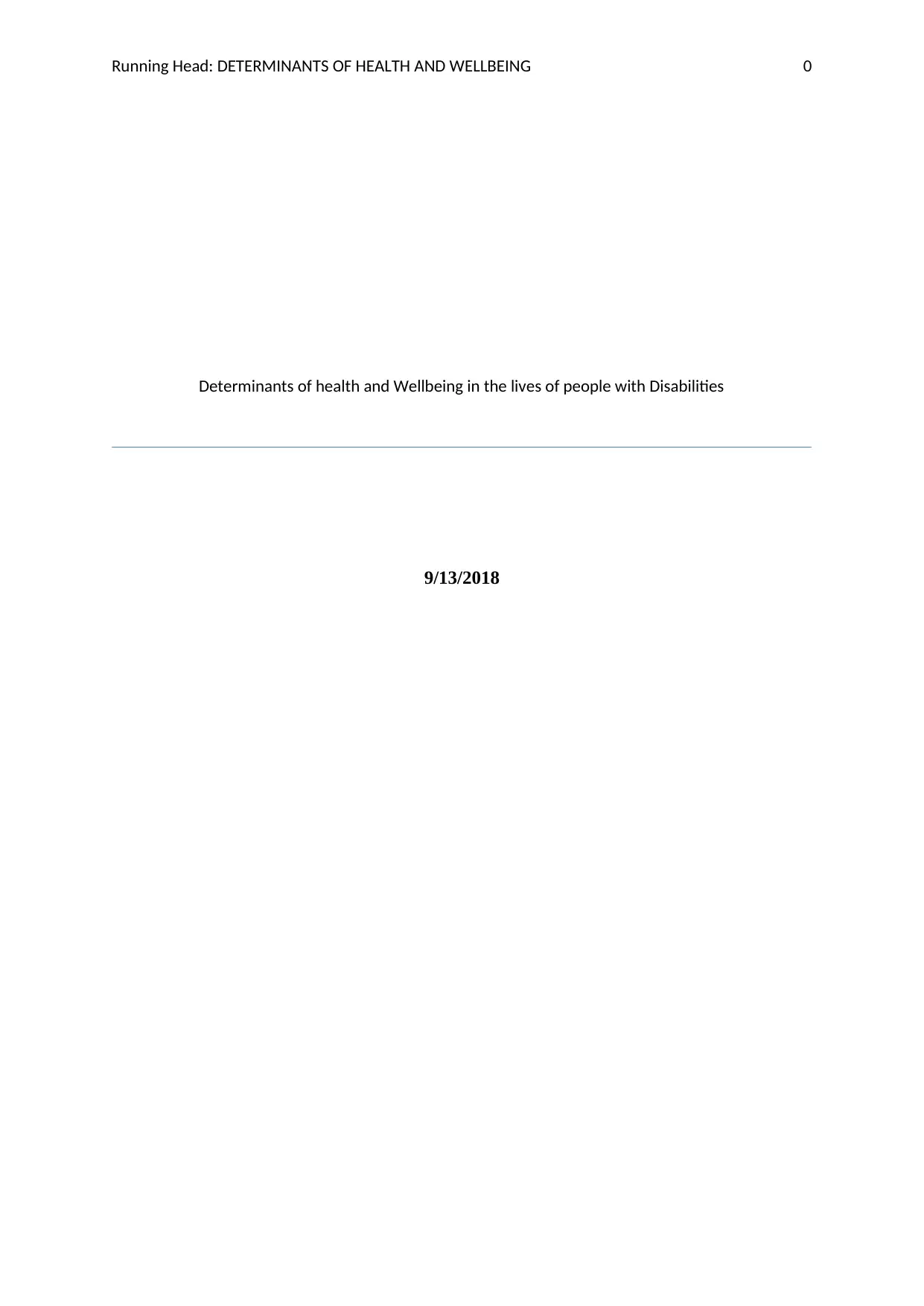
Running Head: DETERMINANTS OF HEALTH AND WELLBEING 0
Determinants of health and Wellbeing in the lives of people with Disabilities
9/13/2018
Determinants of health and Wellbeing in the lives of people with Disabilities
9/13/2018
Paraphrase This Document
Need a fresh take? Get an instant paraphrase of this document with our AI Paraphraser
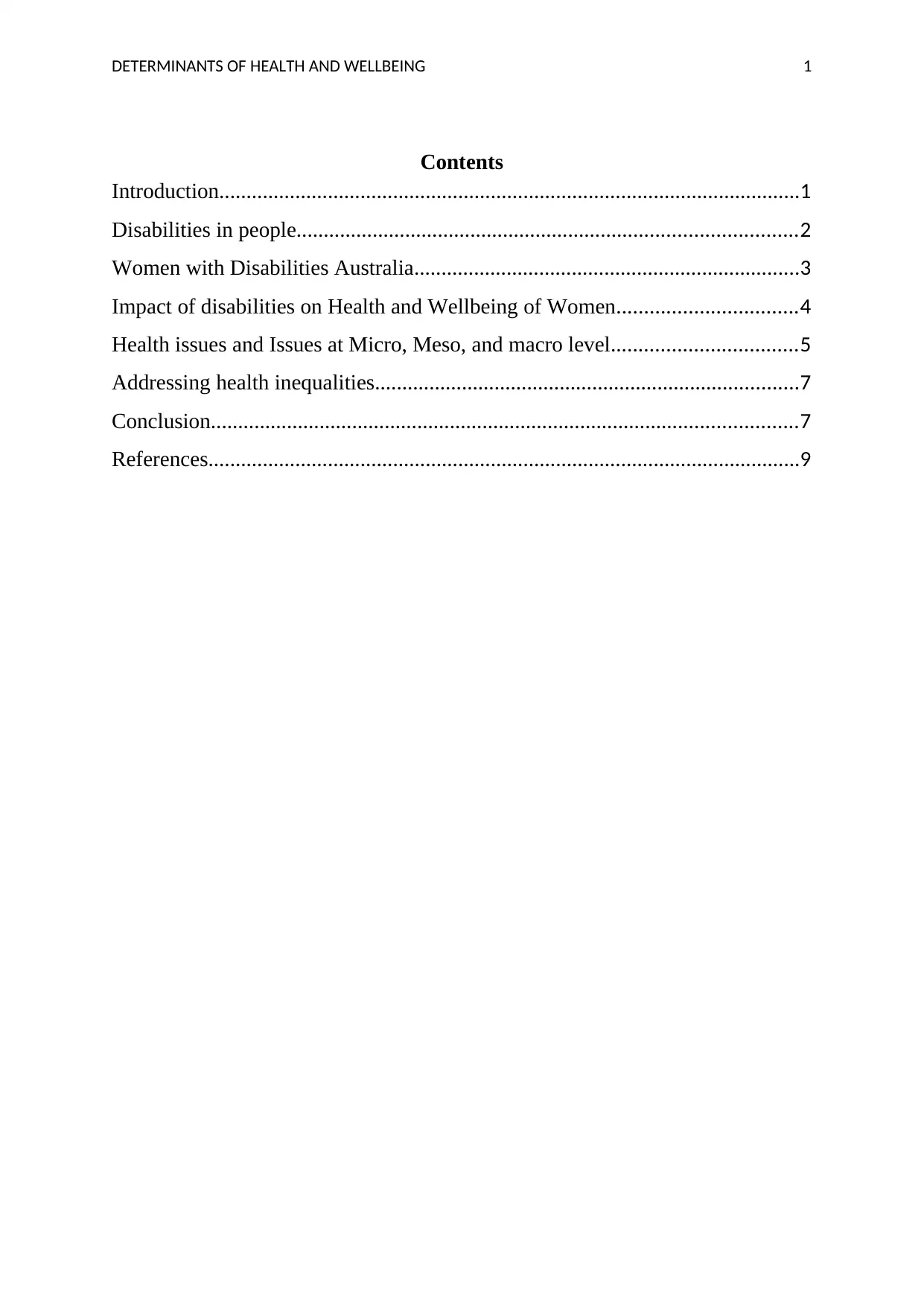
DETERMINANTS OF HEALTH AND WELLBEING 1
Contents
Introduction...........................................................................................................1
Disabilities in people............................................................................................2
Women with Disabilities Australia.......................................................................3
Impact of disabilities on Health and Wellbeing of Women.................................4
Health issues and Issues at Micro, Meso, and macro level..................................5
Addressing health inequalities..............................................................................7
Conclusion............................................................................................................7
References.............................................................................................................9
Contents
Introduction...........................................................................................................1
Disabilities in people............................................................................................2
Women with Disabilities Australia.......................................................................3
Impact of disabilities on Health and Wellbeing of Women.................................4
Health issues and Issues at Micro, Meso, and macro level..................................5
Addressing health inequalities..............................................................................7
Conclusion............................................................................................................7
References.............................................................................................................9
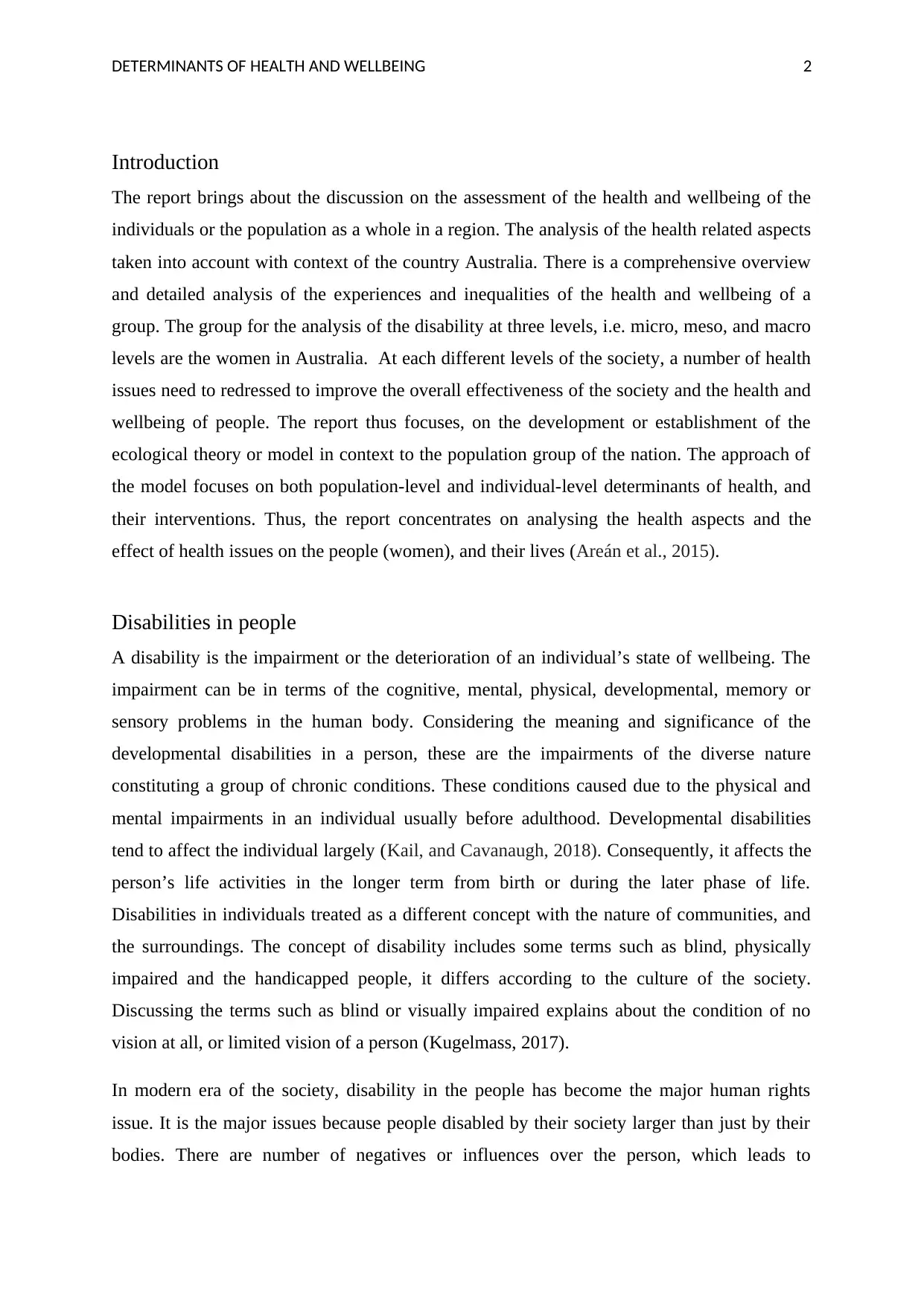
DETERMINANTS OF HEALTH AND WELLBEING 2
Introduction
The report brings about the discussion on the assessment of the health and wellbeing of the
individuals or the population as a whole in a region. The analysis of the health related aspects
taken into account with context of the country Australia. There is a comprehensive overview
and detailed analysis of the experiences and inequalities of the health and wellbeing of a
group. The group for the analysis of the disability at three levels, i.e. micro, meso, and macro
levels are the women in Australia. At each different levels of the society, a number of health
issues need to redressed to improve the overall effectiveness of the society and the health and
wellbeing of people. The report thus focuses, on the development or establishment of the
ecological theory or model in context to the population group of the nation. The approach of
the model focuses on both population-level and individual-level determinants of health, and
their interventions. Thus, the report concentrates on analysing the health aspects and the
effect of health issues on the people (women), and their lives (Areán et al., 2015).
Disabilities in people
A disability is the impairment or the deterioration of an individual’s state of wellbeing. The
impairment can be in terms of the cognitive, mental, physical, developmental, memory or
sensory problems in the human body. Considering the meaning and significance of the
developmental disabilities in a person, these are the impairments of the diverse nature
constituting a group of chronic conditions. These conditions caused due to the physical and
mental impairments in an individual usually before adulthood. Developmental disabilities
tend to affect the individual largely (Kail, and Cavanaugh, 2018). Consequently, it affects the
person’s life activities in the longer term from birth or during the later phase of life.
Disabilities in individuals treated as a different concept with the nature of communities, and
the surroundings. The concept of disability includes some terms such as blind, physically
impaired and the handicapped people, it differs according to the culture of the society.
Discussing the terms such as blind or visually impaired explains about the condition of no
vision at all, or limited vision of a person (Kugelmass, 2017).
In modern era of the society, disability in the people has become the major human rights
issue. It is the major issues because people disabled by their society larger than just by their
bodies. There are number of negatives or influences over the person, which leads to
Introduction
The report brings about the discussion on the assessment of the health and wellbeing of the
individuals or the population as a whole in a region. The analysis of the health related aspects
taken into account with context of the country Australia. There is a comprehensive overview
and detailed analysis of the experiences and inequalities of the health and wellbeing of a
group. The group for the analysis of the disability at three levels, i.e. micro, meso, and macro
levels are the women in Australia. At each different levels of the society, a number of health
issues need to redressed to improve the overall effectiveness of the society and the health and
wellbeing of people. The report thus focuses, on the development or establishment of the
ecological theory or model in context to the population group of the nation. The approach of
the model focuses on both population-level and individual-level determinants of health, and
their interventions. Thus, the report concentrates on analysing the health aspects and the
effect of health issues on the people (women), and their lives (Areán et al., 2015).
Disabilities in people
A disability is the impairment or the deterioration of an individual’s state of wellbeing. The
impairment can be in terms of the cognitive, mental, physical, developmental, memory or
sensory problems in the human body. Considering the meaning and significance of the
developmental disabilities in a person, these are the impairments of the diverse nature
constituting a group of chronic conditions. These conditions caused due to the physical and
mental impairments in an individual usually before adulthood. Developmental disabilities
tend to affect the individual largely (Kail, and Cavanaugh, 2018). Consequently, it affects the
person’s life activities in the longer term from birth or during the later phase of life.
Disabilities in individuals treated as a different concept with the nature of communities, and
the surroundings. The concept of disability includes some terms such as blind, physically
impaired and the handicapped people, it differs according to the culture of the society.
Discussing the terms such as blind or visually impaired explains about the condition of no
vision at all, or limited vision of a person (Kugelmass, 2017).
In modern era of the society, disability in the people has become the major human rights
issue. It is the major issues because people disabled by their society larger than just by their
bodies. There are number of negatives or influences over the person, which leads to
⊘ This is a preview!⊘
Do you want full access?
Subscribe today to unlock all pages.

Trusted by 1+ million students worldwide
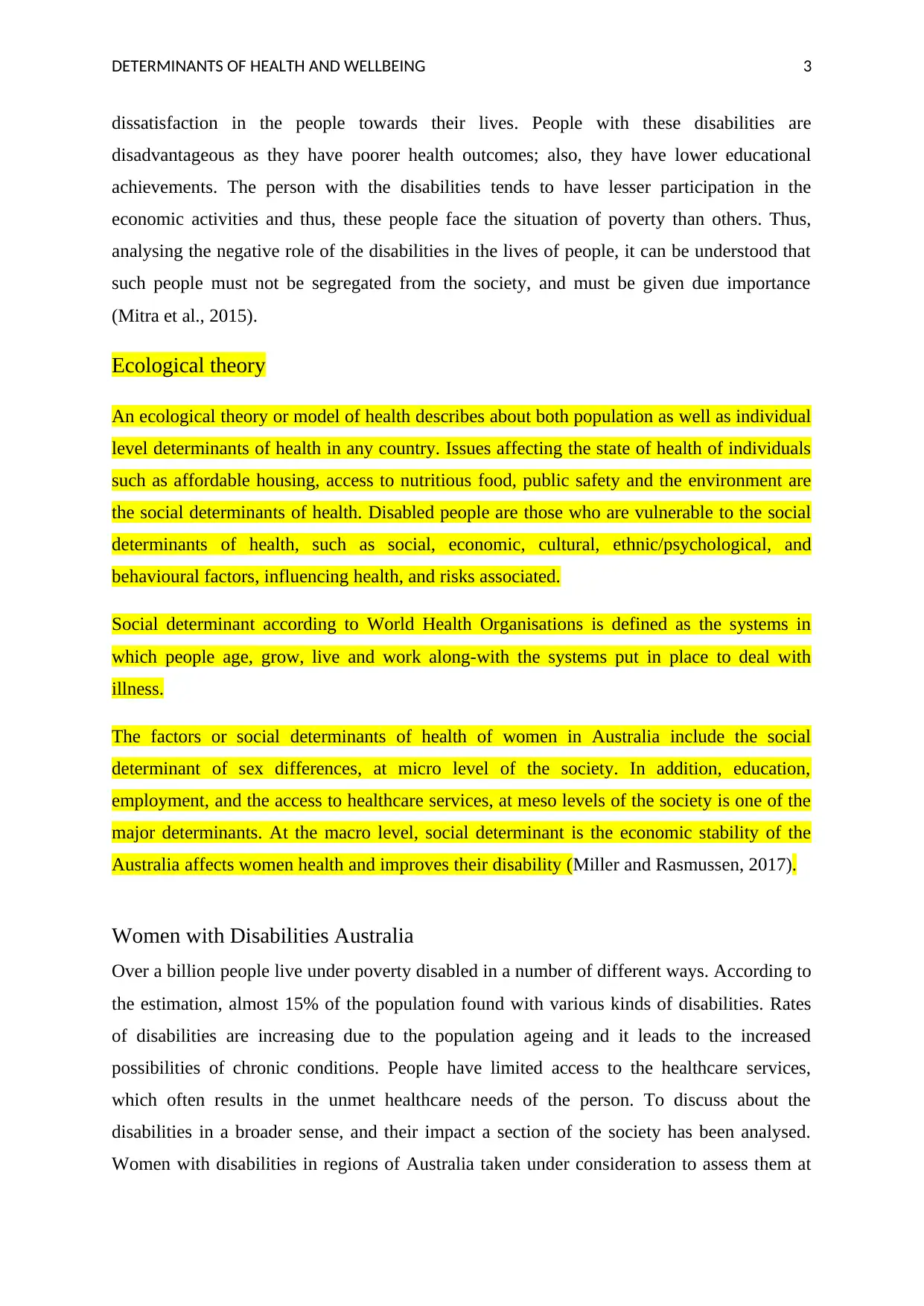
DETERMINANTS OF HEALTH AND WELLBEING 3
dissatisfaction in the people towards their lives. People with these disabilities are
disadvantageous as they have poorer health outcomes; also, they have lower educational
achievements. The person with the disabilities tends to have lesser participation in the
economic activities and thus, these people face the situation of poverty than others. Thus,
analysing the negative role of the disabilities in the lives of people, it can be understood that
such people must not be segregated from the society, and must be given due importance
(Mitra et al., 2015).
Ecological theory
An ecological theory or model of health describes about both population as well as individual
level determinants of health in any country. Issues affecting the state of health of individuals
such as affordable housing, access to nutritious food, public safety and the environment are
the social determinants of health. Disabled people are those who are vulnerable to the social
determinants of health, such as social, economic, cultural, ethnic/psychological, and
behavioural factors, influencing health, and risks associated.
Social determinant according to World Health Organisations is defined as the systems in
which people age, grow, live and work along-with the systems put in place to deal with
illness.
The factors or social determinants of health of women in Australia include the social
determinant of sex differences, at micro level of the society. In addition, education,
employment, and the access to healthcare services, at meso levels of the society is one of the
major determinants. At the macro level, social determinant is the economic stability of the
Australia affects women health and improves their disability (Miller and Rasmussen, 2017).
Women with Disabilities Australia
Over a billion people live under poverty disabled in a number of different ways. According to
the estimation, almost 15% of the population found with various kinds of disabilities. Rates
of disabilities are increasing due to the population ageing and it leads to the increased
possibilities of chronic conditions. People have limited access to the healthcare services,
which often results in the unmet healthcare needs of the person. To discuss about the
disabilities in a broader sense, and their impact a section of the society has been analysed.
Women with disabilities in regions of Australia taken under consideration to assess them at
dissatisfaction in the people towards their lives. People with these disabilities are
disadvantageous as they have poorer health outcomes; also, they have lower educational
achievements. The person with the disabilities tends to have lesser participation in the
economic activities and thus, these people face the situation of poverty than others. Thus,
analysing the negative role of the disabilities in the lives of people, it can be understood that
such people must not be segregated from the society, and must be given due importance
(Mitra et al., 2015).
Ecological theory
An ecological theory or model of health describes about both population as well as individual
level determinants of health in any country. Issues affecting the state of health of individuals
such as affordable housing, access to nutritious food, public safety and the environment are
the social determinants of health. Disabled people are those who are vulnerable to the social
determinants of health, such as social, economic, cultural, ethnic/psychological, and
behavioural factors, influencing health, and risks associated.
Social determinant according to World Health Organisations is defined as the systems in
which people age, grow, live and work along-with the systems put in place to deal with
illness.
The factors or social determinants of health of women in Australia include the social
determinant of sex differences, at micro level of the society. In addition, education,
employment, and the access to healthcare services, at meso levels of the society is one of the
major determinants. At the macro level, social determinant is the economic stability of the
Australia affects women health and improves their disability (Miller and Rasmussen, 2017).
Women with Disabilities Australia
Over a billion people live under poverty disabled in a number of different ways. According to
the estimation, almost 15% of the population found with various kinds of disabilities. Rates
of disabilities are increasing due to the population ageing and it leads to the increased
possibilities of chronic conditions. People have limited access to the healthcare services,
which often results in the unmet healthcare needs of the person. To discuss about the
disabilities in a broader sense, and their impact a section of the society has been analysed.
Women with disabilities in regions of Australia taken under consideration to assess them at
Paraphrase This Document
Need a fresh take? Get an instant paraphrase of this document with our AI Paraphraser
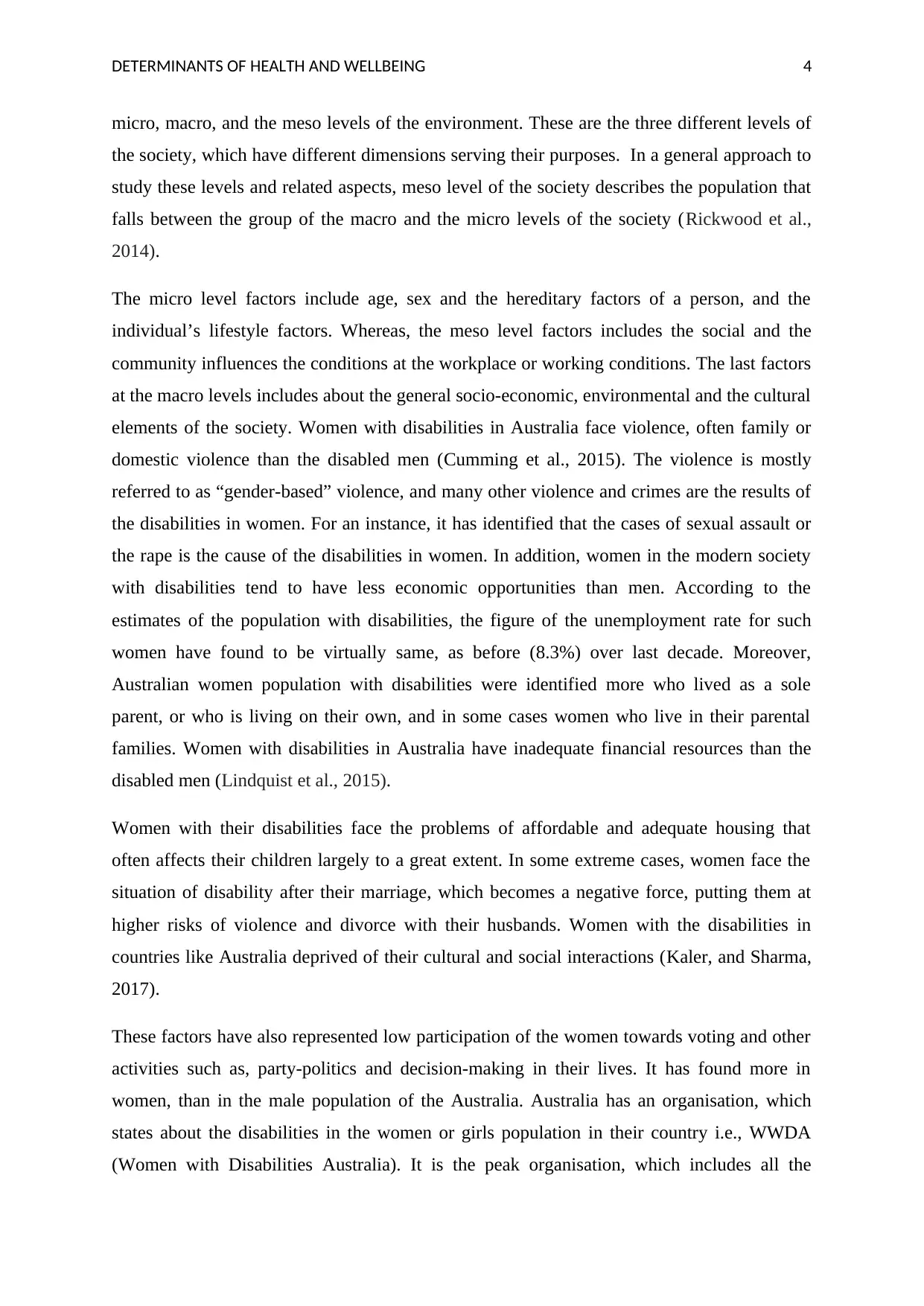
DETERMINANTS OF HEALTH AND WELLBEING 4
micro, macro, and the meso levels of the environment. These are the three different levels of
the society, which have different dimensions serving their purposes. In a general approach to
study these levels and related aspects, meso level of the society describes the population that
falls between the group of the macro and the micro levels of the society (Rickwood et al.,
2014).
The micro level factors include age, sex and the hereditary factors of a person, and the
individual’s lifestyle factors. Whereas, the meso level factors includes the social and the
community influences the conditions at the workplace or working conditions. The last factors
at the macro levels includes about the general socio-economic, environmental and the cultural
elements of the society. Women with disabilities in Australia face violence, often family or
domestic violence than the disabled men (Cumming et al., 2015). The violence is mostly
referred to as “gender-based” violence, and many other violence and crimes are the results of
the disabilities in women. For an instance, it has identified that the cases of sexual assault or
the rape is the cause of the disabilities in women. In addition, women in the modern society
with disabilities tend to have less economic opportunities than men. According to the
estimates of the population with disabilities, the figure of the unemployment rate for such
women have found to be virtually same, as before (8.3%) over last decade. Moreover,
Australian women population with disabilities were identified more who lived as a sole
parent, or who is living on their own, and in some cases women who live in their parental
families. Women with disabilities in Australia have inadequate financial resources than the
disabled men (Lindquist et al., 2015).
Women with their disabilities face the problems of affordable and adequate housing that
often affects their children largely to a great extent. In some extreme cases, women face the
situation of disability after their marriage, which becomes a negative force, putting them at
higher risks of violence and divorce with their husbands. Women with the disabilities in
countries like Australia deprived of their cultural and social interactions (Kaler, and Sharma,
2017).
These factors have also represented low participation of the women towards voting and other
activities such as, party-politics and decision-making in their lives. It has found more in
women, than in the male population of the Australia. Australia has an organisation, which
states about the disabilities in the women or girls population in their country i.e., WWDA
(Women with Disabilities Australia). It is the peak organisation, which includes all the
micro, macro, and the meso levels of the environment. These are the three different levels of
the society, which have different dimensions serving their purposes. In a general approach to
study these levels and related aspects, meso level of the society describes the population that
falls between the group of the macro and the micro levels of the society (Rickwood et al.,
2014).
The micro level factors include age, sex and the hereditary factors of a person, and the
individual’s lifestyle factors. Whereas, the meso level factors includes the social and the
community influences the conditions at the workplace or working conditions. The last factors
at the macro levels includes about the general socio-economic, environmental and the cultural
elements of the society. Women with disabilities in Australia face violence, often family or
domestic violence than the disabled men (Cumming et al., 2015). The violence is mostly
referred to as “gender-based” violence, and many other violence and crimes are the results of
the disabilities in women. For an instance, it has identified that the cases of sexual assault or
the rape is the cause of the disabilities in women. In addition, women in the modern society
with disabilities tend to have less economic opportunities than men. According to the
estimates of the population with disabilities, the figure of the unemployment rate for such
women have found to be virtually same, as before (8.3%) over last decade. Moreover,
Australian women population with disabilities were identified more who lived as a sole
parent, or who is living on their own, and in some cases women who live in their parental
families. Women with disabilities in Australia have inadequate financial resources than the
disabled men (Lindquist et al., 2015).
Women with their disabilities face the problems of affordable and adequate housing that
often affects their children largely to a great extent. In some extreme cases, women face the
situation of disability after their marriage, which becomes a negative force, putting them at
higher risks of violence and divorce with their husbands. Women with the disabilities in
countries like Australia deprived of their cultural and social interactions (Kaler, and Sharma,
2017).
These factors have also represented low participation of the women towards voting and other
activities such as, party-politics and decision-making in their lives. It has found more in
women, than in the male population of the Australia. Australia has an organisation, which
states about the disabilities in the women or girls population in their country i.e., WWDA
(Women with Disabilities Australia). It is the peak organisation, which includes all the
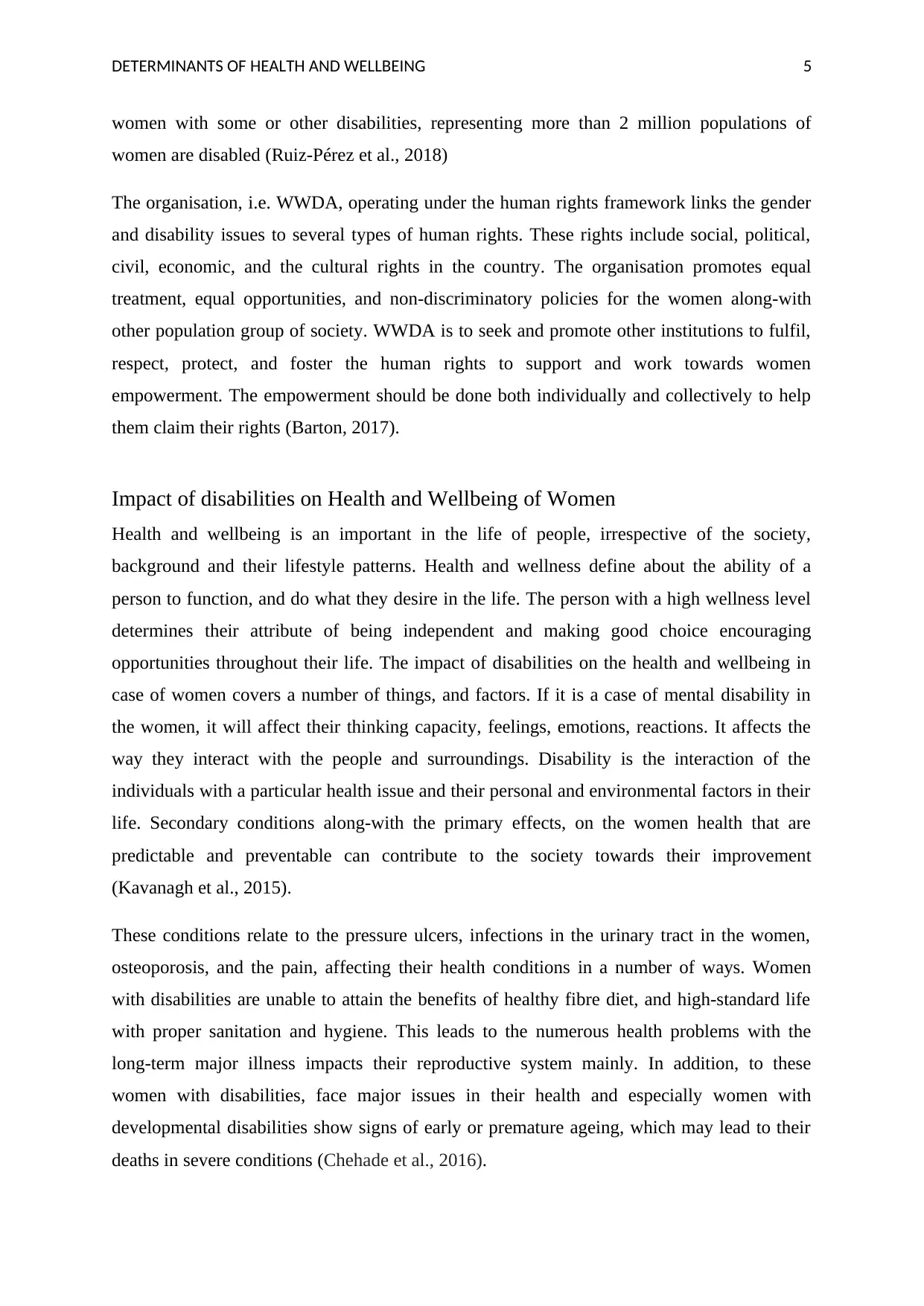
DETERMINANTS OF HEALTH AND WELLBEING 5
women with some or other disabilities, representing more than 2 million populations of
women are disabled (Ruiz-Pérez et al., 2018)
The organisation, i.e. WWDA, operating under the human rights framework links the gender
and disability issues to several types of human rights. These rights include social, political,
civil, economic, and the cultural rights in the country. The organisation promotes equal
treatment, equal opportunities, and non-discriminatory policies for the women along-with
other population group of society. WWDA is to seek and promote other institutions to fulfil,
respect, protect, and foster the human rights to support and work towards women
empowerment. The empowerment should be done both individually and collectively to help
them claim their rights (Barton, 2017).
Impact of disabilities on Health and Wellbeing of Women
Health and wellbeing is an important in the life of people, irrespective of the society,
background and their lifestyle patterns. Health and wellness define about the ability of a
person to function, and do what they desire in the life. The person with a high wellness level
determines their attribute of being independent and making good choice encouraging
opportunities throughout their life. The impact of disabilities on the health and wellbeing in
case of women covers a number of things, and factors. If it is a case of mental disability in
the women, it will affect their thinking capacity, feelings, emotions, reactions. It affects the
way they interact with the people and surroundings. Disability is the interaction of the
individuals with a particular health issue and their personal and environmental factors in their
life. Secondary conditions along-with the primary effects, on the women health that are
predictable and preventable can contribute to the society towards their improvement
(Kavanagh et al., 2015).
These conditions relate to the pressure ulcers, infections in the urinary tract in the women,
osteoporosis, and the pain, affecting their health conditions in a number of ways. Women
with disabilities are unable to attain the benefits of healthy fibre diet, and high-standard life
with proper sanitation and hygiene. This leads to the numerous health problems with the
long-term major illness impacts their reproductive system mainly. In addition, to these
women with disabilities, face major issues in their health and especially women with
developmental disabilities show signs of early or premature ageing, which may lead to their
deaths in severe conditions (Chehade et al., 2016).
women with some or other disabilities, representing more than 2 million populations of
women are disabled (Ruiz-Pérez et al., 2018)
The organisation, i.e. WWDA, operating under the human rights framework links the gender
and disability issues to several types of human rights. These rights include social, political,
civil, economic, and the cultural rights in the country. The organisation promotes equal
treatment, equal opportunities, and non-discriminatory policies for the women along-with
other population group of society. WWDA is to seek and promote other institutions to fulfil,
respect, protect, and foster the human rights to support and work towards women
empowerment. The empowerment should be done both individually and collectively to help
them claim their rights (Barton, 2017).
Impact of disabilities on Health and Wellbeing of Women
Health and wellbeing is an important in the life of people, irrespective of the society,
background and their lifestyle patterns. Health and wellness define about the ability of a
person to function, and do what they desire in the life. The person with a high wellness level
determines their attribute of being independent and making good choice encouraging
opportunities throughout their life. The impact of disabilities on the health and wellbeing in
case of women covers a number of things, and factors. If it is a case of mental disability in
the women, it will affect their thinking capacity, feelings, emotions, reactions. It affects the
way they interact with the people and surroundings. Disability is the interaction of the
individuals with a particular health issue and their personal and environmental factors in their
life. Secondary conditions along-with the primary effects, on the women health that are
predictable and preventable can contribute to the society towards their improvement
(Kavanagh et al., 2015).
These conditions relate to the pressure ulcers, infections in the urinary tract in the women,
osteoporosis, and the pain, affecting their health conditions in a number of ways. Women
with disabilities are unable to attain the benefits of healthy fibre diet, and high-standard life
with proper sanitation and hygiene. This leads to the numerous health problems with the
long-term major illness impacts their reproductive system mainly. In addition, to these
women with disabilities, face major issues in their health and especially women with
developmental disabilities show signs of early or premature ageing, which may lead to their
deaths in severe conditions (Chehade et al., 2016).
⊘ This is a preview!⊘
Do you want full access?
Subscribe today to unlock all pages.

Trusted by 1+ million students worldwide
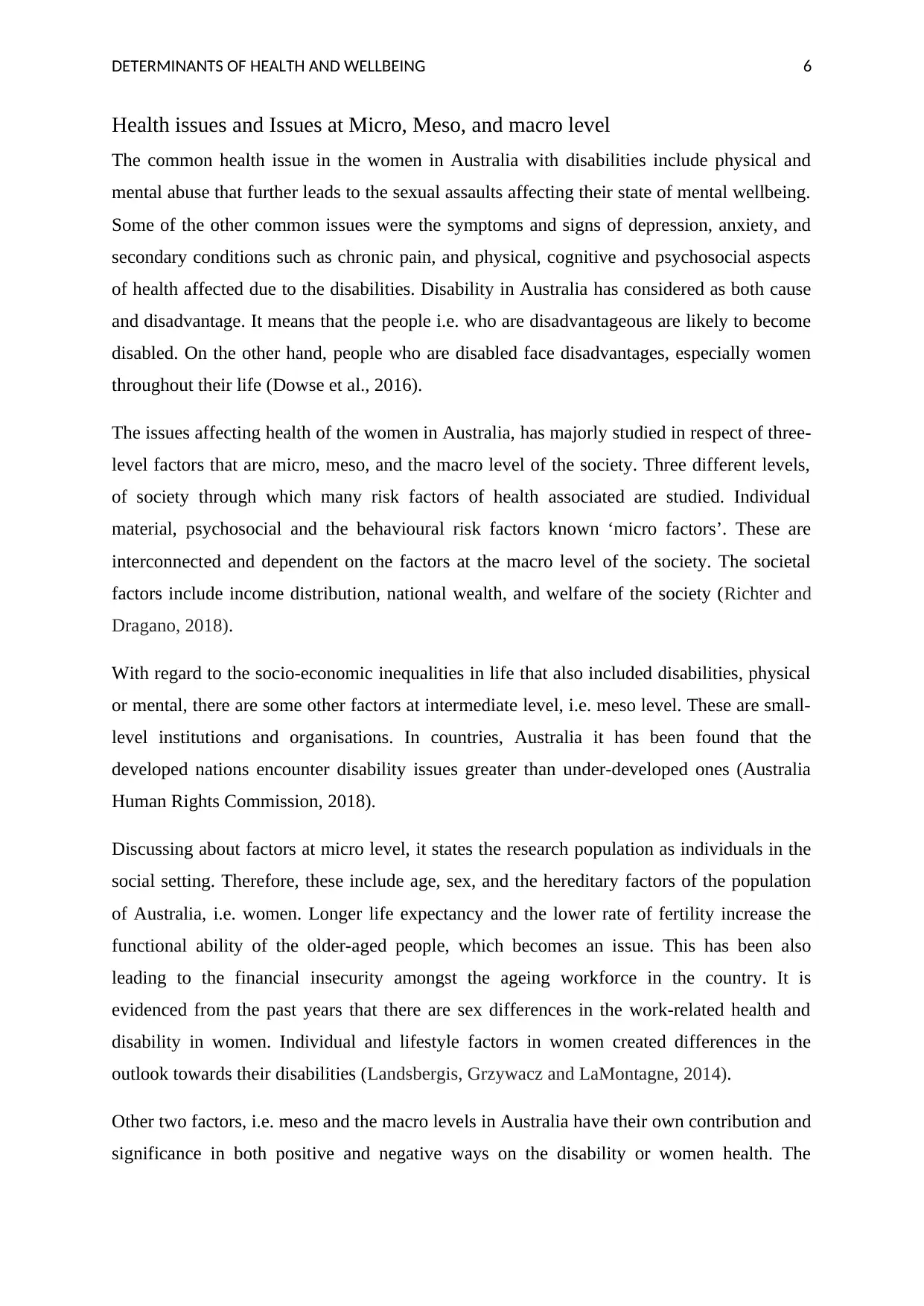
DETERMINANTS OF HEALTH AND WELLBEING 6
Health issues and Issues at Micro, Meso, and macro level
The common health issue in the women in Australia with disabilities include physical and
mental abuse that further leads to the sexual assaults affecting their state of mental wellbeing.
Some of the other common issues were the symptoms and signs of depression, anxiety, and
secondary conditions such as chronic pain, and physical, cognitive and psychosocial aspects
of health affected due to the disabilities. Disability in Australia has considered as both cause
and disadvantage. It means that the people i.e. who are disadvantageous are likely to become
disabled. On the other hand, people who are disabled face disadvantages, especially women
throughout their life (Dowse et al., 2016).
The issues affecting health of the women in Australia, has majorly studied in respect of three-
level factors that are micro, meso, and the macro level of the society. Three different levels,
of society through which many risk factors of health associated are studied. Individual
material, psychosocial and the behavioural risk factors known ‘micro factors’. These are
interconnected and dependent on the factors at the macro level of the society. The societal
factors include income distribution, national wealth, and welfare of the society (Richter and
Dragano, 2018).
With regard to the socio-economic inequalities in life that also included disabilities, physical
or mental, there are some other factors at intermediate level, i.e. meso level. These are small-
level institutions and organisations. In countries, Australia it has been found that the
developed nations encounter disability issues greater than under-developed ones (Australia
Human Rights Commission, 2018).
Discussing about factors at micro level, it states the research population as individuals in the
social setting. Therefore, these include age, sex, and the hereditary factors of the population
of Australia, i.e. women. Longer life expectancy and the lower rate of fertility increase the
functional ability of the older-aged people, which becomes an issue. This has been also
leading to the financial insecurity amongst the ageing workforce in the country. It is
evidenced from the past years that there are sex differences in the work-related health and
disability in women. Individual and lifestyle factors in women created differences in the
outlook towards their disabilities (Landsbergis, Grzywacz and LaMontagne, 2014).
Other two factors, i.e. meso and the macro levels in Australia have their own contribution and
significance in both positive and negative ways on the disability or women health. The
Health issues and Issues at Micro, Meso, and macro level
The common health issue in the women in Australia with disabilities include physical and
mental abuse that further leads to the sexual assaults affecting their state of mental wellbeing.
Some of the other common issues were the symptoms and signs of depression, anxiety, and
secondary conditions such as chronic pain, and physical, cognitive and psychosocial aspects
of health affected due to the disabilities. Disability in Australia has considered as both cause
and disadvantage. It means that the people i.e. who are disadvantageous are likely to become
disabled. On the other hand, people who are disabled face disadvantages, especially women
throughout their life (Dowse et al., 2016).
The issues affecting health of the women in Australia, has majorly studied in respect of three-
level factors that are micro, meso, and the macro level of the society. Three different levels,
of society through which many risk factors of health associated are studied. Individual
material, psychosocial and the behavioural risk factors known ‘micro factors’. These are
interconnected and dependent on the factors at the macro level of the society. The societal
factors include income distribution, national wealth, and welfare of the society (Richter and
Dragano, 2018).
With regard to the socio-economic inequalities in life that also included disabilities, physical
or mental, there are some other factors at intermediate level, i.e. meso level. These are small-
level institutions and organisations. In countries, Australia it has been found that the
developed nations encounter disability issues greater than under-developed ones (Australia
Human Rights Commission, 2018).
Discussing about factors at micro level, it states the research population as individuals in the
social setting. Therefore, these include age, sex, and the hereditary factors of the population
of Australia, i.e. women. Longer life expectancy and the lower rate of fertility increase the
functional ability of the older-aged people, which becomes an issue. This has been also
leading to the financial insecurity amongst the ageing workforce in the country. It is
evidenced from the past years that there are sex differences in the work-related health and
disability in women. Individual and lifestyle factors in women created differences in the
outlook towards their disabilities (Landsbergis, Grzywacz and LaMontagne, 2014).
Other two factors, i.e. meso and the macro levels in Australia have their own contribution and
significance in both positive and negative ways on the disability or women health. The
Paraphrase This Document
Need a fresh take? Get an instant paraphrase of this document with our AI Paraphraser
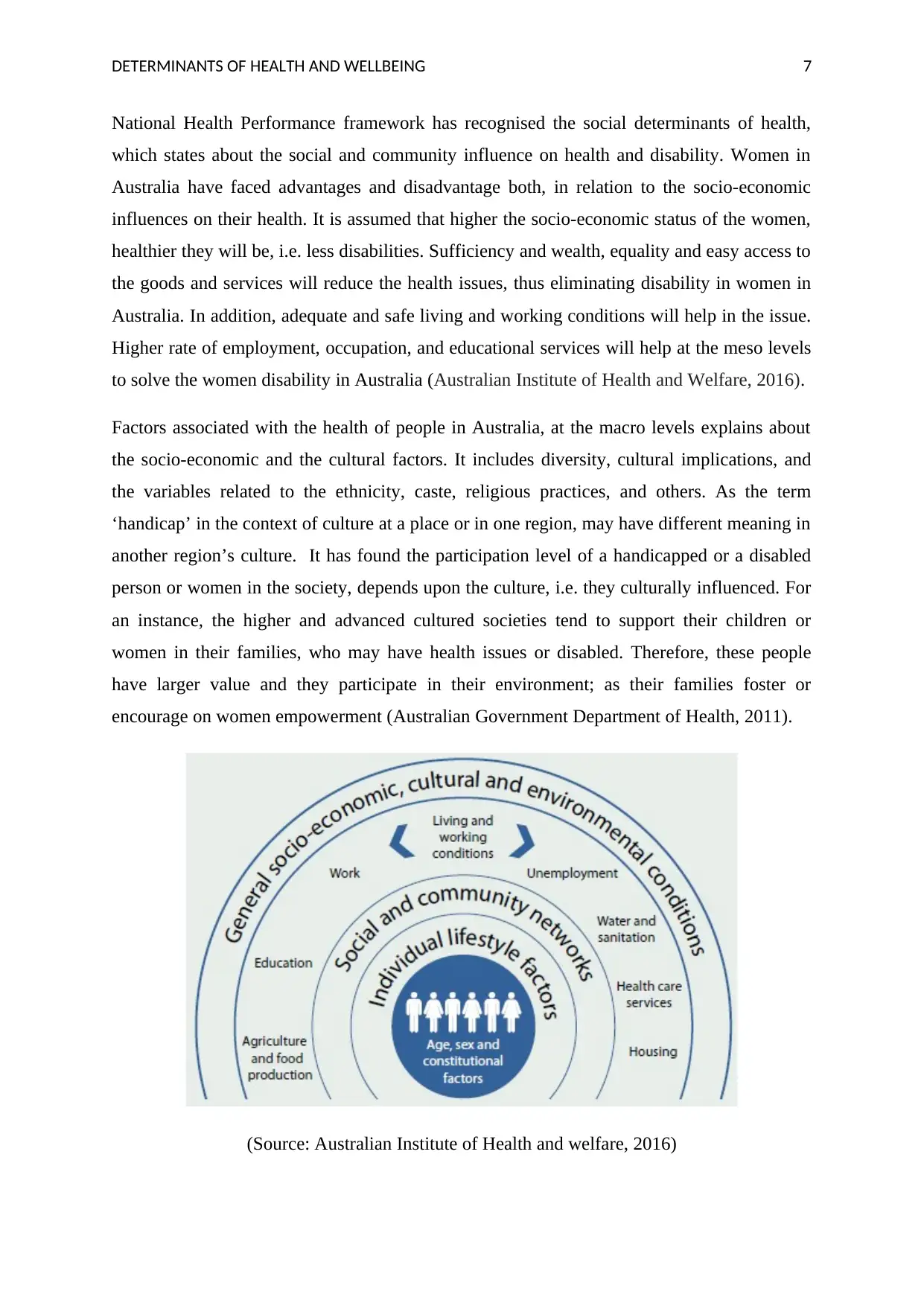
DETERMINANTS OF HEALTH AND WELLBEING 7
National Health Performance framework has recognised the social determinants of health,
which states about the social and community influence on health and disability. Women in
Australia have faced advantages and disadvantage both, in relation to the socio-economic
influences on their health. It is assumed that higher the socio-economic status of the women,
healthier they will be, i.e. less disabilities. Sufficiency and wealth, equality and easy access to
the goods and services will reduce the health issues, thus eliminating disability in women in
Australia. In addition, adequate and safe living and working conditions will help in the issue.
Higher rate of employment, occupation, and educational services will help at the meso levels
to solve the women disability in Australia (Australian Institute of Health and Welfare, 2016).
Factors associated with the health of people in Australia, at the macro levels explains about
the socio-economic and the cultural factors. It includes diversity, cultural implications, and
the variables related to the ethnicity, caste, religious practices, and others. As the term
‘handicap’ in the context of culture at a place or in one region, may have different meaning in
another region’s culture. It has found the participation level of a handicapped or a disabled
person or women in the society, depends upon the culture, i.e. they culturally influenced. For
an instance, the higher and advanced cultured societies tend to support their children or
women in their families, who may have health issues or disabled. Therefore, these people
have larger value and they participate in their environment; as their families foster or
encourage on women empowerment (Australian Government Department of Health, 2011).
(Source: Australian Institute of Health and welfare, 2016)
National Health Performance framework has recognised the social determinants of health,
which states about the social and community influence on health and disability. Women in
Australia have faced advantages and disadvantage both, in relation to the socio-economic
influences on their health. It is assumed that higher the socio-economic status of the women,
healthier they will be, i.e. less disabilities. Sufficiency and wealth, equality and easy access to
the goods and services will reduce the health issues, thus eliminating disability in women in
Australia. In addition, adequate and safe living and working conditions will help in the issue.
Higher rate of employment, occupation, and educational services will help at the meso levels
to solve the women disability in Australia (Australian Institute of Health and Welfare, 2016).
Factors associated with the health of people in Australia, at the macro levels explains about
the socio-economic and the cultural factors. It includes diversity, cultural implications, and
the variables related to the ethnicity, caste, religious practices, and others. As the term
‘handicap’ in the context of culture at a place or in one region, may have different meaning in
another region’s culture. It has found the participation level of a handicapped or a disabled
person or women in the society, depends upon the culture, i.e. they culturally influenced. For
an instance, the higher and advanced cultured societies tend to support their children or
women in their families, who may have health issues or disabled. Therefore, these people
have larger value and they participate in their environment; as their families foster or
encourage on women empowerment (Australian Government Department of Health, 2011).
(Source: Australian Institute of Health and welfare, 2016)
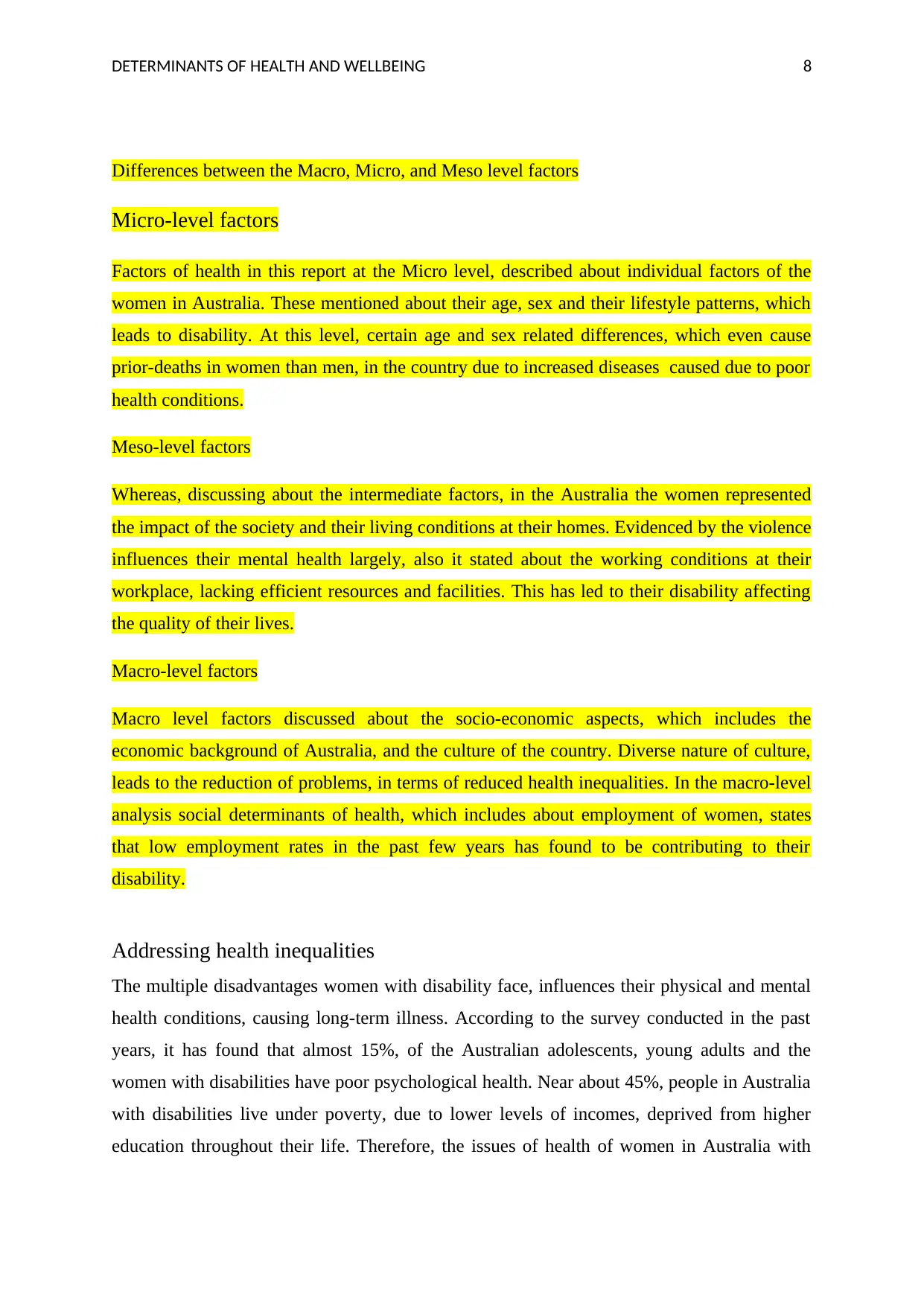
DETERMINANTS OF HEALTH AND WELLBEING 8
Differences between the Macro, Micro, and Meso level factors
Micro-level factors
Factors of health in this report at the Micro level, described about individual factors of the
women in Australia. These mentioned about their age, sex and their lifestyle patterns, which
leads to disability. At this level, certain age and sex related differences, which even cause
prior-deaths in women than men, in the country due to increased diseases caused due to poor
health conditions.
Meso-level factors
Whereas, discussing about the intermediate factors, in the Australia the women represented
the impact of the society and their living conditions at their homes. Evidenced by the violence
influences their mental health largely, also it stated about the working conditions at their
workplace, lacking efficient resources and facilities. This has led to their disability affecting
the quality of their lives.
Macro-level factors
Macro level factors discussed about the socio-economic aspects, which includes the
economic background of Australia, and the culture of the country. Diverse nature of culture,
leads to the reduction of problems, in terms of reduced health inequalities. In the macro-level
analysis social determinants of health, which includes about employment of women, states
that low employment rates in the past few years has found to be contributing to their
disability.
Addressing health inequalities
The multiple disadvantages women with disability face, influences their physical and mental
health conditions, causing long-term illness. According to the survey conducted in the past
years, it has found that almost 15%, of the Australian adolescents, young adults and the
women with disabilities have poor psychological health. Near about 45%, people in Australia
with disabilities live under poverty, due to lower levels of incomes, deprived from higher
education throughout their life. Therefore, the issues of health of women in Australia with
Differences between the Macro, Micro, and Meso level factors
Micro-level factors
Factors of health in this report at the Micro level, described about individual factors of the
women in Australia. These mentioned about their age, sex and their lifestyle patterns, which
leads to disability. At this level, certain age and sex related differences, which even cause
prior-deaths in women than men, in the country due to increased diseases caused due to poor
health conditions.
Meso-level factors
Whereas, discussing about the intermediate factors, in the Australia the women represented
the impact of the society and their living conditions at their homes. Evidenced by the violence
influences their mental health largely, also it stated about the working conditions at their
workplace, lacking efficient resources and facilities. This has led to their disability affecting
the quality of their lives.
Macro-level factors
Macro level factors discussed about the socio-economic aspects, which includes the
economic background of Australia, and the culture of the country. Diverse nature of culture,
leads to the reduction of problems, in terms of reduced health inequalities. In the macro-level
analysis social determinants of health, which includes about employment of women, states
that low employment rates in the past few years has found to be contributing to their
disability.
Addressing health inequalities
The multiple disadvantages women with disability face, influences their physical and mental
health conditions, causing long-term illness. According to the survey conducted in the past
years, it has found that almost 15%, of the Australian adolescents, young adults and the
women with disabilities have poor psychological health. Near about 45%, people in Australia
with disabilities live under poverty, due to lower levels of incomes, deprived from higher
education throughout their life. Therefore, the issues of health of women in Australia with
⊘ This is a preview!⊘
Do you want full access?
Subscribe today to unlock all pages.

Trusted by 1+ million students worldwide
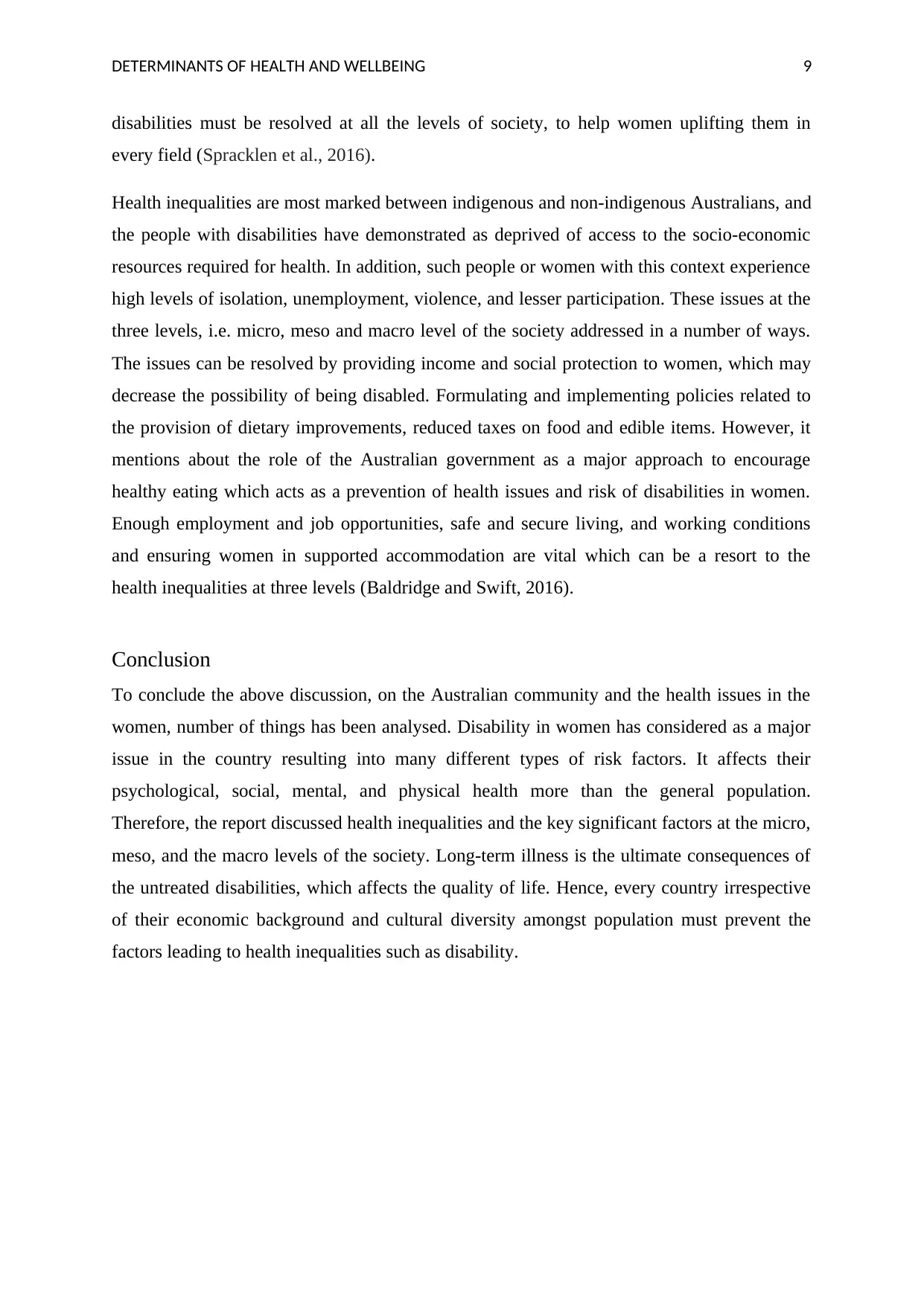
DETERMINANTS OF HEALTH AND WELLBEING 9
disabilities must be resolved at all the levels of society, to help women uplifting them in
every field (Spracklen et al., 2016).
Health inequalities are most marked between indigenous and non-indigenous Australians, and
the people with disabilities have demonstrated as deprived of access to the socio-economic
resources required for health. In addition, such people or women with this context experience
high levels of isolation, unemployment, violence, and lesser participation. These issues at the
three levels, i.e. micro, meso and macro level of the society addressed in a number of ways.
The issues can be resolved by providing income and social protection to women, which may
decrease the possibility of being disabled. Formulating and implementing policies related to
the provision of dietary improvements, reduced taxes on food and edible items. However, it
mentions about the role of the Australian government as a major approach to encourage
healthy eating which acts as a prevention of health issues and risk of disabilities in women.
Enough employment and job opportunities, safe and secure living, and working conditions
and ensuring women in supported accommodation are vital which can be a resort to the
health inequalities at three levels (Baldridge and Swift, 2016).
Conclusion
To conclude the above discussion, on the Australian community and the health issues in the
women, number of things has been analysed. Disability in women has considered as a major
issue in the country resulting into many different types of risk factors. It affects their
psychological, social, mental, and physical health more than the general population.
Therefore, the report discussed health inequalities and the key significant factors at the micro,
meso, and the macro levels of the society. Long-term illness is the ultimate consequences of
the untreated disabilities, which affects the quality of life. Hence, every country irrespective
of their economic background and cultural diversity amongst population must prevent the
factors leading to health inequalities such as disability.
disabilities must be resolved at all the levels of society, to help women uplifting them in
every field (Spracklen et al., 2016).
Health inequalities are most marked between indigenous and non-indigenous Australians, and
the people with disabilities have demonstrated as deprived of access to the socio-economic
resources required for health. In addition, such people or women with this context experience
high levels of isolation, unemployment, violence, and lesser participation. These issues at the
three levels, i.e. micro, meso and macro level of the society addressed in a number of ways.
The issues can be resolved by providing income and social protection to women, which may
decrease the possibility of being disabled. Formulating and implementing policies related to
the provision of dietary improvements, reduced taxes on food and edible items. However, it
mentions about the role of the Australian government as a major approach to encourage
healthy eating which acts as a prevention of health issues and risk of disabilities in women.
Enough employment and job opportunities, safe and secure living, and working conditions
and ensuring women in supported accommodation are vital which can be a resort to the
health inequalities at three levels (Baldridge and Swift, 2016).
Conclusion
To conclude the above discussion, on the Australian community and the health issues in the
women, number of things has been analysed. Disability in women has considered as a major
issue in the country resulting into many different types of risk factors. It affects their
psychological, social, mental, and physical health more than the general population.
Therefore, the report discussed health inequalities and the key significant factors at the micro,
meso, and the macro levels of the society. Long-term illness is the ultimate consequences of
the untreated disabilities, which affects the quality of life. Hence, every country irrespective
of their economic background and cultural diversity amongst population must prevent the
factors leading to health inequalities such as disability.
Paraphrase This Document
Need a fresh take? Get an instant paraphrase of this document with our AI Paraphraser
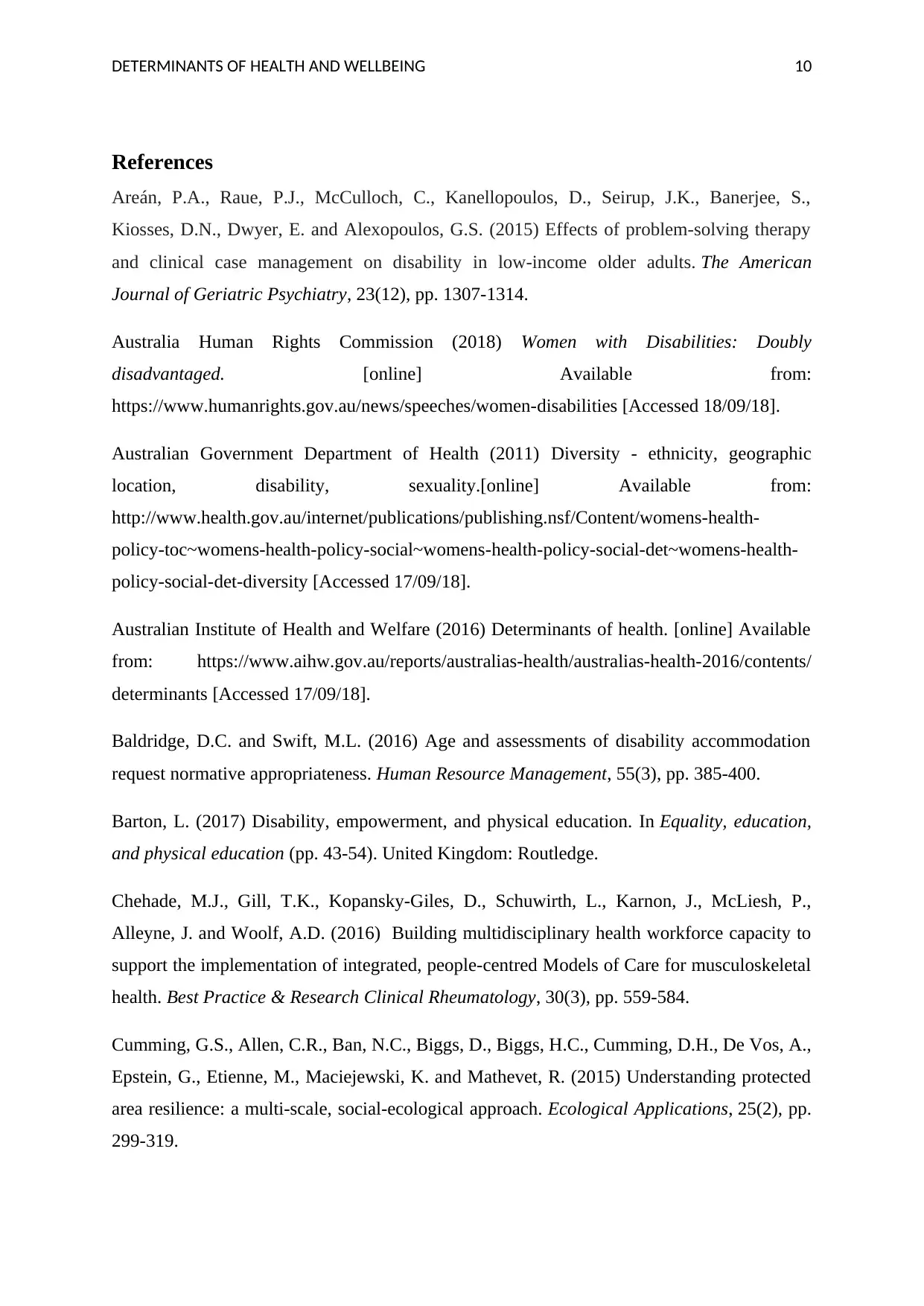
DETERMINANTS OF HEALTH AND WELLBEING 10
References
Areán, P.A., Raue, P.J., McCulloch, C., Kanellopoulos, D., Seirup, J.K., Banerjee, S.,
Kiosses, D.N., Dwyer, E. and Alexopoulos, G.S. (2015) Effects of problem-solving therapy
and clinical case management on disability in low-income older adults. The American
Journal of Geriatric Psychiatry, 23(12), pp. 1307-1314.
Australia Human Rights Commission (2018) Women with Disabilities: Doubly
disadvantaged. [online] Available from:
https://www.humanrights.gov.au/news/speeches/women-disabilities [Accessed 18/09/18].
Australian Government Department of Health (2011) Diversity - ethnicity, geographic
location, disability, sexuality.[online] Available from:
http://www.health.gov.au/internet/publications/publishing.nsf/Content/womens-health-
policy-toc~womens-health-policy-social~womens-health-policy-social-det~womens-health-
policy-social-det-diversity [Accessed 17/09/18].
Australian Institute of Health and Welfare (2016) Determinants of health. [online] Available
from: https://www.aihw.gov.au/reports/australias-health/australias-health-2016/contents/
determinants [Accessed 17/09/18].
Baldridge, D.C. and Swift, M.L. (2016) Age and assessments of disability accommodation
request normative appropriateness. Human Resource Management, 55(3), pp. 385-400.
Barton, L. (2017) Disability, empowerment, and physical education. In Equality, education,
and physical education (pp. 43-54). United Kingdom: Routledge.
Chehade, M.J., Gill, T.K., Kopansky-Giles, D., Schuwirth, L., Karnon, J., McLiesh, P.,
Alleyne, J. and Woolf, A.D. (2016) Building multidisciplinary health workforce capacity to
support the implementation of integrated, people-centred Models of Care for musculoskeletal
health. Best Practice & Research Clinical Rheumatology, 30(3), pp. 559-584.
Cumming, G.S., Allen, C.R., Ban, N.C., Biggs, D., Biggs, H.C., Cumming, D.H., De Vos, A.,
Epstein, G., Etienne, M., Maciejewski, K. and Mathevet, R. (2015) Understanding protected
area resilience: a multi‐scale, social‐ecological approach. Ecological Applications, 25(2), pp.
299-319.
References
Areán, P.A., Raue, P.J., McCulloch, C., Kanellopoulos, D., Seirup, J.K., Banerjee, S.,
Kiosses, D.N., Dwyer, E. and Alexopoulos, G.S. (2015) Effects of problem-solving therapy
and clinical case management on disability in low-income older adults. The American
Journal of Geriatric Psychiatry, 23(12), pp. 1307-1314.
Australia Human Rights Commission (2018) Women with Disabilities: Doubly
disadvantaged. [online] Available from:
https://www.humanrights.gov.au/news/speeches/women-disabilities [Accessed 18/09/18].
Australian Government Department of Health (2011) Diversity - ethnicity, geographic
location, disability, sexuality.[online] Available from:
http://www.health.gov.au/internet/publications/publishing.nsf/Content/womens-health-
policy-toc~womens-health-policy-social~womens-health-policy-social-det~womens-health-
policy-social-det-diversity [Accessed 17/09/18].
Australian Institute of Health and Welfare (2016) Determinants of health. [online] Available
from: https://www.aihw.gov.au/reports/australias-health/australias-health-2016/contents/
determinants [Accessed 17/09/18].
Baldridge, D.C. and Swift, M.L. (2016) Age and assessments of disability accommodation
request normative appropriateness. Human Resource Management, 55(3), pp. 385-400.
Barton, L. (2017) Disability, empowerment, and physical education. In Equality, education,
and physical education (pp. 43-54). United Kingdom: Routledge.
Chehade, M.J., Gill, T.K., Kopansky-Giles, D., Schuwirth, L., Karnon, J., McLiesh, P.,
Alleyne, J. and Woolf, A.D. (2016) Building multidisciplinary health workforce capacity to
support the implementation of integrated, people-centred Models of Care for musculoskeletal
health. Best Practice & Research Clinical Rheumatology, 30(3), pp. 559-584.
Cumming, G.S., Allen, C.R., Ban, N.C., Biggs, D., Biggs, H.C., Cumming, D.H., De Vos, A.,
Epstein, G., Etienne, M., Maciejewski, K. and Mathevet, R. (2015) Understanding protected
area resilience: a multi‐scale, social‐ecological approach. Ecological Applications, 25(2), pp.
299-319.
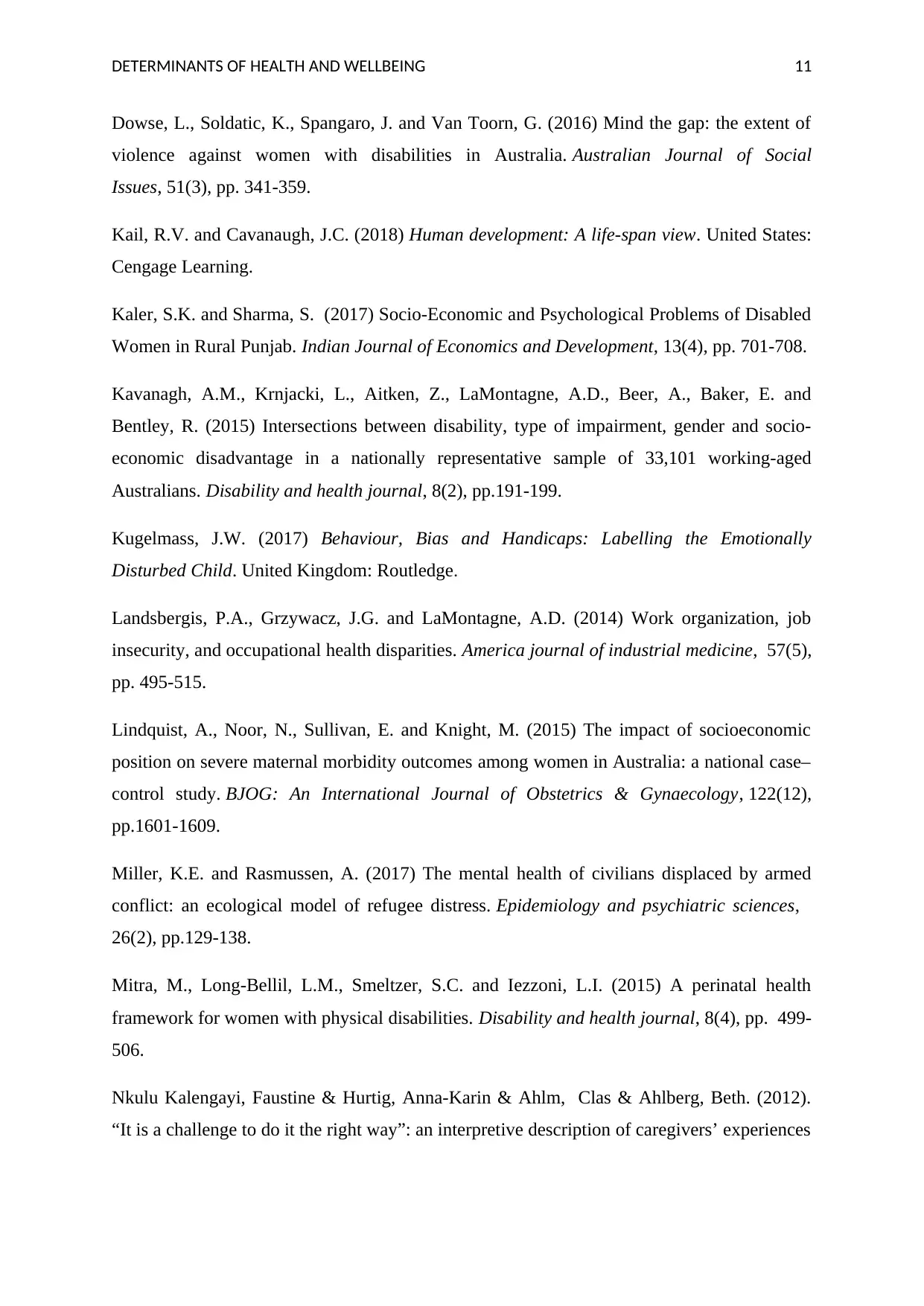
DETERMINANTS OF HEALTH AND WELLBEING 11
Dowse, L., Soldatic, K., Spangaro, J. and Van Toorn, G. (2016) Mind the gap: the extent of
violence against women with disabilities in Australia. Australian Journal of Social
Issues, 51(3), pp. 341-359.
Kail, R.V. and Cavanaugh, J.C. (2018) Human development: A life-span view. United States:
Cengage Learning.
Kaler, S.K. and Sharma, S. (2017) Socio-Economic and Psychological Problems of Disabled
Women in Rural Punjab. Indian Journal of Economics and Development, 13(4), pp. 701-708.
Kavanagh, A.M., Krnjacki, L., Aitken, Z., LaMontagne, A.D., Beer, A., Baker, E. and
Bentley, R. (2015) Intersections between disability, type of impairment, gender and socio-
economic disadvantage in a nationally representative sample of 33,101 working-aged
Australians. Disability and health journal, 8(2), pp.191-199.
Kugelmass, J.W. (2017) Behaviour, Bias and Handicaps: Labelling the Emotionally
Disturbed Child. United Kingdom: Routledge.
Landsbergis, P.A., Grzywacz, J.G. and LaMontagne, A.D. (2014) Work organization, job
insecurity, and occupational health disparities. America journal of industrial medicine, 57(5),
pp. 495-515.
Lindquist, A., Noor, N., Sullivan, E. and Knight, M. (2015) The impact of socioeconomic
position on severe maternal morbidity outcomes among women in Australia: a national case–
control study. BJOG: An International Journal of Obstetrics & Gynaecology, 122(12),
pp.1601-1609.
Miller, K.E. and Rasmussen, A. (2017) The mental health of civilians displaced by armed
conflict: an ecological model of refugee distress. Epidemiology and psychiatric sciences,
26(2), pp.129-138.
Mitra, M., Long-Bellil, L.M., Smeltzer, S.C. and Iezzoni, L.I. (2015) A perinatal health
framework for women with physical disabilities. Disability and health journal, 8(4), pp. 499-
506.
Nkulu Kalengayi, Faustine & Hurtig, Anna-Karin & Ahlm, Clas & Ahlberg, Beth. (2012).
“It is a challenge to do it the right way”: an interpretive description of caregivers’ experiences
Dowse, L., Soldatic, K., Spangaro, J. and Van Toorn, G. (2016) Mind the gap: the extent of
violence against women with disabilities in Australia. Australian Journal of Social
Issues, 51(3), pp. 341-359.
Kail, R.V. and Cavanaugh, J.C. (2018) Human development: A life-span view. United States:
Cengage Learning.
Kaler, S.K. and Sharma, S. (2017) Socio-Economic and Psychological Problems of Disabled
Women in Rural Punjab. Indian Journal of Economics and Development, 13(4), pp. 701-708.
Kavanagh, A.M., Krnjacki, L., Aitken, Z., LaMontagne, A.D., Beer, A., Baker, E. and
Bentley, R. (2015) Intersections between disability, type of impairment, gender and socio-
economic disadvantage in a nationally representative sample of 33,101 working-aged
Australians. Disability and health journal, 8(2), pp.191-199.
Kugelmass, J.W. (2017) Behaviour, Bias and Handicaps: Labelling the Emotionally
Disturbed Child. United Kingdom: Routledge.
Landsbergis, P.A., Grzywacz, J.G. and LaMontagne, A.D. (2014) Work organization, job
insecurity, and occupational health disparities. America journal of industrial medicine, 57(5),
pp. 495-515.
Lindquist, A., Noor, N., Sullivan, E. and Knight, M. (2015) The impact of socioeconomic
position on severe maternal morbidity outcomes among women in Australia: a national case–
control study. BJOG: An International Journal of Obstetrics & Gynaecology, 122(12),
pp.1601-1609.
Miller, K.E. and Rasmussen, A. (2017) The mental health of civilians displaced by armed
conflict: an ecological model of refugee distress. Epidemiology and psychiatric sciences,
26(2), pp.129-138.
Mitra, M., Long-Bellil, L.M., Smeltzer, S.C. and Iezzoni, L.I. (2015) A perinatal health
framework for women with physical disabilities. Disability and health journal, 8(4), pp. 499-
506.
Nkulu Kalengayi, Faustine & Hurtig, Anna-Karin & Ahlm, Clas & Ahlberg, Beth. (2012).
“It is a challenge to do it the right way”: an interpretive description of caregivers’ experiences
⊘ This is a preview!⊘
Do you want full access?
Subscribe today to unlock all pages.

Trusted by 1+ million students worldwide
1 out of 13
Related Documents
Your All-in-One AI-Powered Toolkit for Academic Success.
+13062052269
info@desklib.com
Available 24*7 on WhatsApp / Email
![[object Object]](/_next/static/media/star-bottom.7253800d.svg)
Unlock your academic potential
Copyright © 2020–2025 A2Z Services. All Rights Reserved. Developed and managed by ZUCOL.





